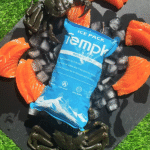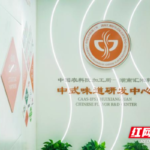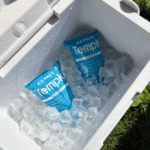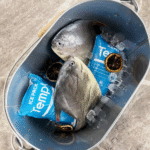Versand temperaturempfindlicher Produkte mit 14″ × 13″ Kühlpackungen können entmutigend wirken, Aber Sie können die Sicherheit Ihrer Waren gewährleisten, indem Sie verstehen, wie Kältemittel funktionieren, Isolierung und Handhabung arbeiten zusammen. Dieser Leitfaden beantwortet praktische Fragen mit 2025 Trends und reale Daten. Am Ende, Sie wissen genau, wie diese flexiblen Eisdecken in eine moderne Kühlkette passen und wie sie im Vergleich zu Trockeneis abschneiden, Gelpackungen und Phasenwechselmaterialien. Ob Sie Essenspakete versenden, Impfstoffe oder Kosmetika, Die folgenden Tipps helfen Ihnen, den Verderb zu reduzieren und die Kundenzufriedenheit zu verbessern.
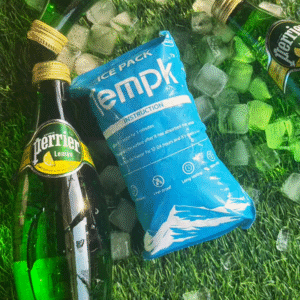
Wie geht's? 14″ × 13″ Versand von Kühlakkus Wir arbeiten daran, verderbliche Waren zu schützen? – erklärt ihre Polymerstruktur und thermischen Eigenschaften mithilfe der langlebigen Gel-Technologie.
Wann sollten Sie sich für Kühlakkus vs. Trockeneis oder andere Kältemittel? – beschreibt Temperaturbereiche, Gewichtsverhältnisse und Sicherheitsregeln.
Welche Verpackungsstrategien verlängern die Abkühlzeit? 24, 48 Und 72 Stundenversand? – Bietet Schritt-für-Schritt-Tipps und Lastdiagramme.
Welche 2025 Kühlkettentrends wirken sich auf die Verpackungsauswahl aus? – deckt Automatisierung ab, Nachhaltigkeit und Echtzeitverfolgung.
Wie können Sie mit den neuesten Innovationen Abfall reduzieren und Kosten optimieren?? – erforscht umweltfreundliche Gele und intelligente Sensoren.
Wie erfolgt der Versand von Kühlakkus 14″ × 13″ arbeiten?
14″ × 13″ Kühlakkus sind flexible Polymerdecken, die über längere Zeiträume Wärme absorbieren und Kühlenergie abgeben. Im Gegensatz zu starren Eissteinen, Diese Decken enthalten ein Gel auf Wasserbasis, das von einer haltbaren Folie umgeben ist. Das Gel verfügt über eine halbfeste Polymermatrix (häufig Natriumpolyacrylat) das langsamer gefriert und auftaut als normales Wasser, sorgt für hervorragende Kältespeicherung und Auslaufsicherheit. Jede Decke besteht aus Gitterzellen (Typischerweise 96) das sich ohne Kleckern auf die richtige Größe zuschneiden lässt, Dadurch sind sie vielseitig für verschiedene Kartonabmessungen geeignet.
Warum Polymergele wichtig sind
Längere Kühldauer: Polymergele gefrieren bei niedrigeren Temperaturen als reines Wasser, Dadurch bleiben sie länger kalt.
Auslaufsicheres Design: Die versiegelte Folie verhindert Kondensation oder Auslaufen, Schutz von Etiketten und sensiblen Produkten.
Wiederverwendbar und langlebig: Hochwertige Gelpackungen können mehrmals wieder eingefroren werden, Kosten sparen und Abfall reduzieren.
Sichere Optionen entleeren: Einige Gele, wie Nordic® Drain Safe®, sind so konstruiert, dass sie ungiftig sind und sicher im kommunalen Abwasser verarbeitet werden können.
| Vergleich | Traditionelles Eis | 14″ × 13″ Polymer-Gel-Packung | Praktische Implikationen |
| Kühlmedium | Gefrorenes Wasser | Gel auf Wasserbasis mit Polymeren | Gele halten die Kälte länger aufrecht, Reduzierung des benötigten Kältemittels |
| Struktur | Ein starrer Block | Flexible Decke mit mehreren Zellen | Lässt sich um unregelmäßige Ladungen falten & passt 14″ × 13″ Kartongrößen |
| Leckgefahr | Hoch wie Eis schmilzt | Gering aufgrund der auslaufsicheren Folie | Schützt Kartons und Etiketten |
| Wiederverwendbar | Oftmals zum einmaligen Gebrauch | Wiederverwendbar; Einige Typen sind abflusssicher | Geringere Umweltbelastung |
Praktische Anwendungstipps für 14″ × 13″ Packungen
Einfrieren vollständig: Kühlen Sie die Packung über Nacht bei −20 °C, damit sie gleichmäßig fest wird. Eine vollständig gefrorene Packung sorgt für längere Haltezeiten.
Zustand bei Bedarf: Für empfindliche Produkte (Z.B., Impfungen), Tauen Sie die gefrorene Packung auf, bis sie matschig wird. Konditionierte Packungen verhindern Gefrierbrand, geben aber dennoch Kälte ab.
Passend zugeschnitten: Schneiden Sie mit einer Schere zwischen den einzelnen Zellen; Die Barrierefolie verhindert das Austreten von Gel. Legen Sie die Packung um das Produkt herum, um den Oberflächenkontakt zu maximieren.
Intelligente Schichten: Legen Sie Kühlakkus auf die Waren – Kaltluftsenken –, sodass die gekühlte Luft nach unten zirkulieren kann.
Wirklicher Fall: Eine Marke für Kochutensilien, die auf Polymer-Kühlakkus umstellt, reduziert Schadensersatzansprüche 8 % Zu 1 % auf zweitägigen Sommerrouten bei gleichzeitiger Reduzierung des Versandgewichts 18 %.
Kühlakkus vs. Trockeneis: Welches Kältemittel sollten Sie verwenden??
Wählen Sie zwischen 14″ × 13″ Kühlakku und Trockeneis hängen von der Zieltemperatur ab, Produktempfindlichkeit und Laufzeit. Kühlakkus halten die Waren bei einer Temperatur von 2–8 °C; Trockeneis hält –78 °C aufrecht und eignet sich besser für gefrorene Sendungen.
Wenn Kühlakkus sinnvoll sind
Kühlakkus eignen sich hervorragend, wenn Sie eine sanfte Kühlung benötigen, ohne das Produkt einzufrieren. Gelpackungen werden gleichmäßig abgegeben, mäßige Kälte, die Schokolade schützt, Kosmetika und Arzneimittel, die unten abgebaut werden 0 °C. Verwenden Sie etwa ein Drittel des Nutzlastgewichts in Gelpacks, um bis zu zu halten 48 Std., Anpassung an die Umgebungstemperatur.
| Faktor | Kaltpackungen | Trockeneis | Implikationen |
| Temperaturbereich | 2 - - 15 °C | –78 ° C. (gefroren) | Wählen Sie basierend auf der Produkttoleranz |
| Gefahreneinstufung | Im Allgemeinen ungefährlich | Klasse 9 Wenn >2.5 kg | Beeinträchtigt den Papierkram und die Ausbildung |
| Halte die Zeit (48 H) | Benötigt ca. 0,35 kg pro kg Nutzlast | Bedürfnisse 1 kg pro kg Nutzlast | Planen Sie die Kartongröße entsprechend |
| Entsorgung | Recycelbare Folie und Gele | Sublimiert zu CO₂-Gas | Kundenkomfort vs. Entlüftungssicherheit |
Wenn Trockeneis unschlagbar ist
Trockeneis ist ideal für Sendungen, die vollständig gefroren bleiben müssen, wie Eis, Zelltherapeutika oder fettreiche Fleischstücke. Es absorbiert 571 kJ pro Kilogramm während der Sublimation und hält die Ware bis zu gefroren 72 Std.. Zur Planung Ihrer Kältemittelbeladung:
Für Übernachtsendungen, Packen Sie die Hälfte des Nutzlastgewichts in Trockeneis.
Für 48 Stundenlieferungen, Verwenden Sie eine gleiche Menge Trockeneis.
Für 72 Stundenrouten, Verwenden Sie das 1,5-fache des Nutzlastgewichts.
Sicherheitsschnappschuss: Tragen Sie immer isolierte Handschuhe, das Paket entlüften (20–30 mm² Entlüftungsfläche) und kennzeichnen Sie die Sendung mit „UN1845 – Trockeneis“, wenn Sie mehr als verwenden 2.5 kg.
Hybride Ansätze
Viele Unternehmen nutzen mittlerweile Hybrid-Kühlmittelsätze die Gelpackungen und Trockeneis kombinieren. Forschungsprojekte a 9 % durchschnittliche jährliche Wachstumsrate für Hybridbausätze durch 2028 da Marken Kosten und Nachhaltigkeit in Einklang bringen. In einem Hybrid-Setup, Legen Sie Gelpackungen unter das Produkt, um extreme Kälte abzufedern, Dann legen Sie Trockeneis darauf; Dadurch verlängert sich die Haltezeit um acht bis zehn Stunden.
Verpackungsstrategien für 24, 48 Und 72 Stundenlieferungen
Die richtige Verpackung geht über die Auswahl eines Kältemittels hinaus; es erfordert die Berechnung von Lastverhältnissen, Schichten anordnen und Isolierung auswählen. So verwenden Sie 14″ × 13″ Kühlpackungen effektiv über gängige Transportfenster hinweg.
24 Stunde gekühlter Versand
Nutzungsverhältnis 0.2 × Nutzlastgewicht: Für Sendungen unter 25 °C, 0.2 kg Gel pro kg Produkt ist ausreichend.
Isolierung auswählen: Ein leichter, isolierter Versandkarton oder eine Luftpolsterfolie kann ausreichen; zumindest sicherstellen 1 Zoll Schaumstoff oder gleichwertiger R-Wert.
Vorkühlprodukte: Kühlen Sie die Artikel vor dem Verpacken, um die thermische Belastung der Gelpackungen zu verringern.
48Stunde gekühlter Versand
Erhöhen Sie das Verhältnis zu 0.35 × Nutzlastgewicht wenn die Umgebungstemperatur dazwischen liegt 25 °C und 32 °C. Für einen 5 kg Nutzlast, das bedeutet ungefähr 1.7 kg Gel.
Verwenden Sie reflektierende Liner: Fügen Sie eine reflektierende Luftpolsterfolie oder Baumwollfolie hinzu, um die Strahlungswärme zu reduzieren.
Konditionieren Sie die Packungen entsprechend: Für Pharmazeutika, Verwenden Sie konditionierte Gelpackungen (matschig) um das Einfrieren empfindlicher Fläschchen zu vermeiden.
72Stundenversand oder extreme Hitze
Verhältnis 0.5 × Nutzlastgewicht plus Isolierung: Für Laufzeiten über 48 Stunden oder Umgebungstemperaturen überschreiten 32 °C, verwenden 0.5 kg Gel pro kg plus Thermofutter. A 10 kg Nutzlast würde ca. erfordern 5 kg Gel.
Erwägen Sie eine Hybridkühlung: Legen Sie für die letzten 12–24 Stunden einen kleinen Trockeneiseinsatz darauf.
Überwachen Sie die Temperatur: Verwenden Sie Datenlogger oder intelligente Sensoren, um interne Bedingungen zu verfolgen.
Gel-Pack-Ladungswähler
| Transitzeit | Umgebungsreichweite | Empfohlenes Gelgewicht | Was es für Sie bedeutet |
| ≤ 24 H | < 25 °C | 0.2 × Ladegewicht | Niedrigste Frachtkosten – geeignet für die Lieferung über Nacht |
| 24–48 h | 25–32 °C | 0.35 × Ladegewicht | Ausgewogene Kosten und Sicherheit – fügen Sie im Sommer einen zusätzlichen Rucksack hinzu |
| > 48 H | > 32 °C | 0.5 × Ladegewicht + Thermalauskleidung | Sorgenfreiheit bei hochwertigen Gütern – denken Sie über eine Hybridlösung mit Trockeneis nach |
Checkliste für das professionelle Packen
Ladung vorkühlen: Beginnen Sie mit gekühlten oder gefrorenen Waren, um die anfängliche Beladung zu reduzieren.
Den Behälter auskleiden: Verwenden Sie eine isolierte Auskleidung (Schaum, Baumwolle, oder reflektierende Blase) um die Wärmeübertragung zu minimieren.
Kühlakkus richtig platzieren: Platzieren Sie Gelpacks um und über der Nutzlast; Vermeiden Sie es, sie direkt auf zerbrechliche Gegenstände zu legen.
Hohlräume füllen: Reduzieren Sie Lufteinschlüsse mit Papier oder Luftpolsterfolie, um Konvektion zu verhindern.
Dicht verschließen: Verschließen Sie den Karton mit haltbarem Klebeband und minimieren Sie die Öffnungen.
Verwenden Sie Temperaturindikatoren: Fügen Sie einen Zeit-Temperatur-Indikator oder einen Datenlogger hinzu, um die Einhaltung sicherzustellen.
Grundlagen der Kühlkettenverpackung für 2025
Bestandteile einer effektiven Kühlkettenverpackung
Beim Verpacken in der Kühlkette kommt es darauf an, dass mehrere Komponenten zusammenarbeiten:
Isolierte Behälter: Materialien wie Polystyrol oder Polyurethanschaum, manchmal mit metallisierter Polyfolie laminiert, reduzieren die Wärmeübertragung. Sie sind als Boxliner erhältlich, Beutel, Palettenabdeckungen und Versandtaschen.
Kältemittel: Gelpackungen, Trockeneis oder Phasenwechselmaterialien (PCMs) sorgen für Kühlung. Kühlakkus sind ideal für Bereiche von 2–15 °C, während PCMs auf bestimmte Sollwerte abzielen können.
Temperaturüberwachungsgeräte: Echtzeit-Datenlogger oder -indikatoren bieten Einblick in die Temperaturbedingungen, Sicherstellen, dass die Produkte innerhalb der erforderlichen Grenzen bleiben.
Robuste Außenverpackung: Wellkartons oder Hartschalenkoffer schützen vor physischen Schäden.
Isolierung und Leistung des Gelpacks
Der R-Wert und die Dicke der Isolierung haben großen Einfluss darauf, wie lange Gel-Packs wirksam bleiben. In einem gut isolierten Behälter (wie zum Beispiel eine Kühlbox aus expandiertem Polystyrol), Die Umgebungstemperatur bleibt stabil, Reduzierung der Arbeitsbelastung des Gels. Eine dickere Isolierung trägt dazu bei, die Innentemperatur länger niedrig zu halten, während dünne Pappe oder einwelliges Wellpappe schnell Wärme eindringen lassen können. Wählen Sie immer Behältermaterialien aus, die für die Transportdauer und das Umgebungsprofil geeignet sind.
Zusammensetzung und thermische Eigenschaften der Gelpackung
Gelpackungen bestehen typischerweise aus Wasser, ein polymeres Geliermittel (wie Natriumpolyacrylat), ein Stabilisator und manchmal Konservierungsstoffe. Diese Inhaltsstoffe bestimmen den Schmelzpunkt und die Wärmeaufnahmefähigkeit. Ein höherer Wassergehalt ermöglicht eine stärkere Wärmeabsorption, kann jedoch die Gelstabilität verringern. Das Geliermittel verwandelt die flüssige Mischung in einen halbfesten Stoff, der nicht ausläuft und flexibel bleibt. Stabilisatoren verhindern, dass das Gel zerfällt, während Konservierungsstoffe die Haltbarkeit verlängern.
Konditionierende Gelpackungen für Arzneimittel
Pharmazeutische Produkte erfordern oft einen strengen Temperaturbereich von 2–8 °C. Gefrorene Gelpackungen (–20 °C bis –25 °C) Die Temperaturen können unter den sicheren Bereich fallen und die Impfstoffe schädigen. Um dies zu vermeiden, Konditionieren Sie die Packungen: Erwärmen Sie sie bei Zimmertemperatur, bis sie sich zu verflüssigen beginnen 0 °C. Konditionierte Packungen sorgen für Kühlung ohne Gefrieren, Gewährleistung der Produktintegrität.
Wenn kühle oder warme Packungen benötigt werden
Coole Gelpacks bleiben Sie im Kühlschrank, aber nicht gefroren. Sie beseitigen das Gefrierrisiko, haben aber eine kürzere Kühlleistung.
Warme Gelpackungen werden bei Raumtemperatur aufbewahrt, um frostempfindliche Produkte im Winterklima zu schützen. Verwenden Sie sie bei extremer Kälte, um zu verhindern, dass die Waren zu kalt werden.
2025 Trends, die die Kühlkettenlogistik prägen
Automatisierung und Robotik
Die Kühlkette entwickelt sich rasant weiter. Automatisierung und Robotik stehen im Mittelpunkt da Lager mit Arbeitskräftemangel und steigenden Kosten konfrontiert sind. Automatisierte Lager- und Bereitstellungssysteme (AS/RS) und Roboterhandhaber rationalisieren Prozesse, Reduzieren Sie menschliche Fehler und verbessern Sie den Durchsatz. Noch, um 80 % der Lager sind immer noch nicht automatisiert, was auf ein enormes Wachstumspotenzial schließen lässt.
Nachhaltigkeit als zentraler Wert
Umweltbedenken und strengere Vorschriften rücken die Nachhaltigkeit in den Vordergrund. Energieeffiziente Kühlung, erneuerbare Energiequellen und nachhaltige Verpackungen werden immer wichtiger. Die globale Infrastruktur für die Lebensmittelkühlkette trägt etwa dazu bei 2 % der weltweiten CO₂-Emissionen, treiben die Nachfrage nach umweltfreundlicheren Lösungen voran. Unternehmen setzen biologisch abbaubare und recycelbare Gelpackungen und Isoliermaterialien ein, um Abfall zu reduzieren. Abflusssichere Gele wie Nordic® Drain Safe® können sicher in den Abfluss geschüttet werden.
End-to-End-Sichtbarkeit und IoT
Die Aufrechterhaltung der Produktqualität erfordert eine Echtzeitüberwachung. IoT-fähige Ortungsgeräte liefern kontinuierliche Daten vor Ort, Temperatur und Luftfeuchtigkeit. Mithilfe der Echtzeitüberwachung können Unternehmen Routen optimieren und Schäden verhindern. In 2022, das Hardware-Segment machte mehr als aus 76.4 % des Kühlkettenverfolgungsmarktes, und die Akzeptanz nimmt weiter zu.
Modernisierung der Infrastruktur
In die Jahre gekommene Kühllager werden modernisiert moderne Kühlung, bessere Isolierung und erneuerbare Energie vor Ort. Investitionen in Compliance und Energieeffizienz sind entscheidend, um wettbewerbsfähig zu bleiben. Der Schwerpunkt der Modernisierung liegt auf der Verbesserung der Isolierung, Implementierung der Datenerfassung und -analyse, und die Erzeugung erneuerbarer Energie, um steigende Stromkosten auszugleichen.
Künstliche Intelligenz und Vorhersageanalytik
KI verändert das Kühlkettenmanagement. Algorithmen des maschinellen Lernens können die Nachfrage vorhersagen, Optimieren Sie die Routenführung und prognostizieren Sie die Gerätewartung. Durch die Analyse historischer und Echtzeitdaten, KI hilft, Risiken zu mindern und die Entscheidungsfindung zu verbessern.
Wachstum in der pharmazeutischen Kühlkette und der Logistik für frische Lebensmittel
Der Pharmasektor treibt die Ausweitung der Kühlkette erheblich voran; um 20 % Bei den in der Entwicklung befindlichen Medikamenten handelt es sich um gen- und zellbasierte Therapien eine präzise Temperaturregelung erfordern. Der globale Markt für pharmazeutische Kühlketten wird voraussichtlich wachsen 1.454 Milliarden US-Dollar von 2029 mit einer CAGR von 4.71 % aus 2024 Zu 2029. Gleichzeitig, Es wird prognostiziert, dass der nordamerikanische Markt für Lebensmittelkühlkettenlogistik einen Aufschwung erleben wird 86,67 Milliarden US-Dollar im Jahr 2025. Online-Bestellungen und Direktverkäufe an Verbraucher erfordern eine verbesserte Zustellung auf der letzten Meile und bessere Kühlkettenfunktionen.
Strategische Partnerschaften und Datenstandardisierung
Zusammenarbeit zwischen Lebensmittelherstellern, Verpackungslieferanten und Technologieanbieter verbessern die Produktentwicklung und rationalisieren die Lieferketten. Von 2025, 74 % Es wird erwartet, dass die Anzahl der Logistikdaten standardisiert wird, Dies ermöglicht eine nahtlose Integration über gesamte Lieferketten hinweg.
Häufig gestellte Fragen
Q1: Kann ich 14 wiederverwenden?″ × 13″ Kaltpackungen?
Ja. Hochwertige Gelpackungen sind für mehrere Zyklen ausgelegt; Frieren Sie sie zwischen den Anwendungen vollständig ein. Einige abflusssichere Gele ermöglichen eine sichere Entsorgung im Abfluss, wenn sie nicht mehr benötigt werden.
Q2: Wie verhindere ich Kondensation oder Schwitzen??
Verwenden keine Schweißgelpackungen oder Packungen in saugfähiges Papier einwickeln. No-Sweat-Packungen sind ideal für papieretikettierte Produkte und Geschenkboxen.
Q3: Was macht eine Packung 14 aus?″ × 13″?
Dies bezieht sich auf die Abmessungen der flexiblen Eisdecke. Standard 14″ × 13″ Blätter haben Gitterzellen (normalerweise 96) und kann ohne Undichtigkeiten auf kleinere Größen zugeschnitten werden.
Q4: Sind Kühlakkus in Flugzeugen erlaubt??
Ja. Gelpackungen sind im Allgemeinen ungefährlich und unterliegen keiner besonderen Handhabung, im Gegensatz zu Trockeneis, das zur Klasse wird 9 Gefahrgut oben 2.5 kg.
Q5: Wie soll ich gebrauchte Gelpackungen entsorgen??
Erkundigen Sie sich bei Ihrem örtlichen Recyclingprogramm. Viele Gelpackungen enthalten recycelbare Folie und ungiftiges Gel. Abflusssichere Produkte können in den Abfluss geschüttet werden.
Zusammenfassung und Empfehlungen
Der Versand temperaturempfindlicher Güter erfordert eine sorgfältige Planung. 14″ × 13″ Kühlakkus bieten Flexibilität, Wiederverwendbare Kühlung, die Produkte im sicheren Temperaturbereich von 2–8 °C hält. Sie eignen sich hervorragend für Pralinen, Kosmetika und Pharmazeutika, sorgt für sanfte Kühlung ohne Gefrieren. Für gefrorene Sendungen oder längere Laufzeiten, Trockeneis bleibt die beste Option, obwohl es eine Entlüftung erfordert, Kennzeichnung und mehr Gewicht. Hybrid-Kits Die Kombination von Gelpackungen und Trockeneis nimmt zu, bietet ein ausgewogenes Verhältnis zwischen Kosten und Leistung. Verwenden Sie Lastverhältnisse (0.2–0,5 × Nutzlast) und ordnungsgemäße Isolierung nach Plan 24, 48und 72-Stunden-Lieferungen. Bleiben Sie informiert über 2025 Trends: Automatisierung, Nachhaltigkeit, IoT, KI und neue Vorschriften verändern die Kühlkettenlogistik. Durch Befolgen dieser Richtlinien, Sie können den Verderb reduzieren, Erfüllen Sie regulatorische Anforderungen und verbessern Sie die Kundenzufriedenheit.
Umsetzbare nächste Schritte
Bewerten Sie die Temperaturanforderungen Ihres Produkts: Bestimmen Sie, ob Ihre Waren gekühlt werden müssen (2–8 ° C) oder gefroren (–20 °C oder niedriger) Bedingungen.
Wählen Sie das richtige Kältemittel: Verwenden Sie 14″ × 13″ Gelpackungen für gekühlte Waren, Trockeneis für Tiefkühlware oder ein Hybridsystem für lange Strecken.
Lastverhältnis berechnen: Wenden Sie die Richtlinien zum Gelgewicht an (0.2–0,5 × Nutzlast) und an die Umgebungsbedingungen anpassen.
Wählen Sie eine isolierte Verpackung: Wählen Sie Materialien mit ausreichendem R-Wert, wie Polystyrol- oder Polyurethan-Auskleidungen.
Überwachungsgeräte einbetten: Integrieren Sie Temperaturindikatoren oder IoT-Sensoren, um eine durchgängige Sichtbarkeit zu gewährleisten.
Bleiben Sie auf dem Laufenden 2025 Trends: Verfolgen Sie die Entwicklungen in der Automatisierung, Nachhaltige Materialien und KI zur Optimierung Ihrer Kühlkette.
Testen und validieren: Führen Sie Bahntests durch, um sicherzustellen, dass Ihre Verpackungslösung die erforderlichen Temperaturen beibehält, und passen Sie sie bei Bedarf an.
Über Tempk
Bei Tempk, Wir entwickeln nachhaltige Thermoverpackungen, die Waren ohne sperrigen Schaum sicher aufbewahren. Unsere Gelpacks auf pflanzlicher Basis und AeroFlex™-Liner bieten branchenführende Isolierung und reduzieren gleichzeitig den Müll auf der Mülldeponie 70 %. Wir arbeiten mit Partnern aus der gesamten Pharmabranche zusammen, Lebensmittel und Biotechnologie zum Design maßgeschneiderte Kühlkettenlösungen. Unser Team arbeitet rund um die Uhr daran, Sie bei der Verpackungsoptimierung zu unterstützen, Einhaltung gesetzlicher Vorschriften und Logistikeffizienz.
Brauche maßgeschneiderte Ratschläge? Buchen Sie noch heute eine kostenlose Beratung mit unseren Kühlketteningenieuren. Wir helfen Ihnen dabei, die ideale Kombination von Kühlakkus zu ermitteln, Isolierung und Überwachung für Ihr spezifisches Produkt und Ihre Route.

















